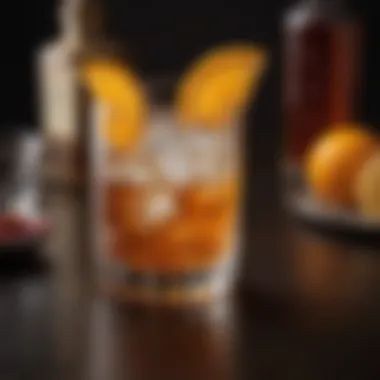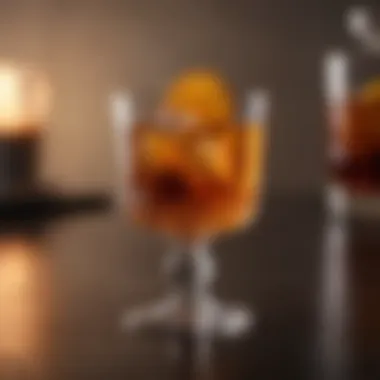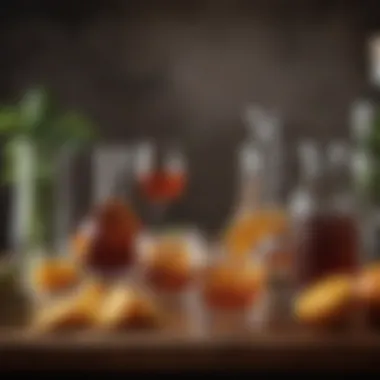A Proper Old Fashioned: Classic Cocktail Insights


Intro
The Old Fashioned stands as a timeless symbol in the realm of cocktails, representing a literary and cultural legacy that has evolved over centuries. Its allure lies not just in its taste but in the intricate layers of its history and preparation. This classic drink is much more than a simple combination of ingredients; it embodies the craft of mixology, offering both a nod to tradition and a canvas for modern interpretation.
In this article, we will dissect the Old Fashioned thoroughly, from its origins to the nuances that make this cocktail a staple in bars around the world. Understanding its basic construction is essential, but diving deeper into its variations and modern takes reveals the dynamic nature of this seemingly straightforward drink.
With a mix of history and practical guidance, both novices and experienced cocktail enthusiasts can appreciate this classic. Thus, whether your aim is to craft a flawless drink at home or to simply understand the artistry behind it, this exploration will enhance your appreciation for the Old Fashioned in all its forms.
Preamble to the Old Fashioned
The Old Fashioned is more than just a cocktail; it is a glimpse into the history of mixology and the evolution of drink culture. This classic drink has retained its status over the decades, solidifying itself as a staple in bars worldwide. Understanding the Old Fashioned encompasses not only its distinctive taste but also its significance within cocktail history. By delving into this cocktail, one can appreciate the artistry behind its simple yet elegant construction.
The Old Fashioned serves as a practical example of how a few quality ingredients can harmoniously blend to create a complex flavor profile. It emphasizes the importance of balance and technique in cocktail preparation. This section will explore both the definition and the historical context that shaped the Old Fashioned into what it is today.
Definition and Significance
An Old Fashioned is defined mainly by its use of whiskey, sugar, bitters, and a twist of citrus. This foundational recipe highlights the straightforward nature of the drink, a hallmark of its enduring appeal. The significance of the Old Fashioned lies in its role as a benchmark for cocktails. It is often regarded as the archetype from which many cocktails derived, illustrating the concept that less can be more.
Notably, the Old Fashioned encapsulates the philosophy of drinking culture that seeks quality over quantity. It invites enthusiasts to appreciate subtle flavors and the craftsmanship involved in its preparation. This cocktail is not merely a beverage; it is an experience, a celebration of simplicity and tradition in an age often dominated by complexity.
Historical Context
The origins of the Old Fashioned can be traced back to the early 19th century, when drinks were constructed with base spirits, sugar, water, and bitters. The term "Old Fashioned" began to emerge in the late 1800s in response to the rise of more elaborate cocktails that featured numerous ingredients. Whiskey was the preferred spirit due to its widespread popularity at the time.
Historically, the Old Fashioned found its place in the social fabric of various eras. During the Prohibition era in the United States, its simple construction allowed it to remain favored among those who still sought to enjoy a drink. The cocktail carried on through the decades, adapting to the influences of different social scenes, yet never losing its essence.
In recent decades, the resurgence of craft cocktails has brought the Old Fashioned back into the limelight. Bartenders and enthusiasts alike recognize it as a touchstone of cocktail history, celebrating its ability to maintain relevance in a constantly changing landscape. With its profound legacy, the Old Fashioned does not merely endure; it thrives, inviting new generations to rediscover its curated balance of flavors.
Ingredients of a Traditional Old Fashioned
The success of an Old Fashioned lies heavily in its ingredients. Each component contributes to the drink's overall flavor and character, allowing for a rich yet straightforward experience. A proper understanding of these elements is critical for both the novice and the seasoned mixologist alike. When prepared with care, the Old Fashioned stands as an exemplary representation of balance in cocktails.
Base Spirits
Whiskey Types
The base spirit of an Old Fashioned is primarily whiskey, which gives the cocktail its fundamental identity. Different types of whiskey, such as bourbon and rye, bring unique characteristics. Bourbon tends to yield a sweeter profile due to its higher corn content, while rye whiskey offers a spicier and more robust flavor. The distinctiveness of these spirits plays a significant role in shaping the cocktail's final taste. Using high-quality whiskey enhances the drink, making it more enjoyable.
Bourbon vs. Rye
Choosing between bourbon and rye is often up to personal preference, but each whiskey type contributes distinctly to the Old Fashioned. Bourbon, with its caramel and vanilla notes, typically appeals to those who prefer a smoother taste. Rye's spiciness can provide a more complex experience. The contrast of flavors in either version can create a satisfying drink. The choice of spirits ultimately influences not just taste but the entire drinking experience.
Sweetening Agents
Sugar Cubes


Sugar cubes are the traditional sweetener for an Old Fashioned. They dissolve slowly and allow for the gradual melding of sweetness with the drink's other components. Using them can create a more balanced drink. They lend a slight texture that enhances the overall sensory experience. However, they require a bit more time to dissolve fully, which might lead to an uneven sweetness if not managed well.
Syrups and Alternatives
Syrups present another option for sweetening an Old Fashioned. Simple syrup mixes easily with the other ingredients, ensuring a uniform sweetness. This method appeals to many who favor convenience. Variations, such as flavored syrups, may add another layer of complexity. However, these alternatives might overshadow the whiskey's character if used too liberally.
Bitters and Their Importance
Bitters are a crucial component in shaping the flavor profile of an Old Fashioned. They provide depth and balance, intensifying the overall experience. The bitterness counterpoints the sweetness, creating a harmonious blend of flavors, which is essential in achieving the traditional taste.
Types of Bitters
There are many types of bitters available, but Angostura bitters are the classic choice. Their aromatic blend perfectly complements the whiskey, adding subtle hints of spices and herbs. Other bitters, such as orange bitters, can also be used for a brighter finish. Each type of bitters brings its nuances, allowing for personalization of the drink. The diversity among bitters enables varying degrees of complexity.
Flavor Profiles
Understanding flavor profiles is essential to mastering the Old Fashioned. The combination of the whiskey's inherent notes with the selected bitters can elevate the drink. For instance, pairing a bourbon with aromatic bitters accentuates warmth and sweetness. Experimenting with different bitters can drastically change the drink’s atmosphere. This exploration can lead to an array of unique interpretations that suit one’s palate.
Garnishing Elements
Garnishes are not merely decorative; they enhance the cocktail’s aromatic profile and provide visual appeal.
Orange Peel
Orange peel is a classic garnish for an Old Fashioned. It offers a refreshing and fragrant touch that beautifully contrasts the drink's depth. The essential oils released from the peel add brightness while complementing the whiskey. Its use is significant in achieving a complete drinking experience.
Cherry Variations
Cherry is another popular garnish, often used for its sweetness. Maraschino cherries provide a nostalgic touch, while fresh, muddled cherries can offer a fuller taste. Different cherries can accentuate various aspects of the drink, impacting sweetness and texture. The choice of cherry may seem minor, but it influences both the visual and taste experience of the cocktail.
By understanding and carefully selecting these ingredients, one can create a truly authentic and rewarding Old Fashioned cocktail. Each component plays an integral role and allows for individual expression, ensuring the drink remains a beloved classic in the world of mixology.
Techniques for Crafting the Perfect Old Fashioned
Creating an Old Fashioned is not just about mixing a few ingredients together. The methods employed can significantly affect the drink's overall taste and character. This section discusses essential techniques for crafting a traditional Old Fashioned. Understanding these techniques ensures that drink enthusiasts can achieve a consistent and high-quality cocktail every time.
Preparation Process
The preparation process for an Old Fashioned is crucial. This drink requires careful attention to each step. First, one must select the right glass. The classic Old Fashioned glass is typically short and sturdy. This design enhances the experience as it showcases the drink and allows for a firm grip.
Next, start by placing a sugar cube in the glass. Some prefer using simple syrup, but sugar cubes remain the classic choice. Moisten the sugar with a few dashes of aromatic bitters. Muddling these ingredients together helps create a firm foundation of flavor.
After achieving a paste-like consistency, it's time to introduce the base spirit. Bourbon or rye whiskey works best, depending on personal preference. Add a large ice cube or several smaller ones, then pour the spirit over them. Stir gently to combine and chill the ingredients. This promotes a balanced distribution of flavors. Finally, garnish with a twist of orange peel, expressing the oils over the drink. This not only adds aroma but also a visual appeal that enhances the overall experience.
Mixology Best Practices


When crafting any cocktail, including the Old Fashioned, best practices can elevate the quality of the drink. Here, we focus on two critical aspects: stirring vs. shaking and layering flavors.
Stirring vs. Shaking
The choice between stirring and shaking can affect the drink's texture and dilution. Stirring is the preferred method for an Old Fashioned. It maintains the drink's clarity while providing a gentle blend of the ingredients.
A key characteristic of stirring is its ability to cool the cocktail without introducing much air. The result is a smoother mouthfeel, which many drinkers prefer. On the other hand, shaking can create more unrest and aeration, which may not complement the Old Fashioned's profile.
Stirring the Old Fashioned also allows for a greater control of dilution. Since the drink is typically served in a short glass, maintaining the right water-to-spirit ratio is essential for achieving balance.
Layering Flavors
Layering flavors creates complexity and depth in a drink. For an Old Fashioned, it's about ensuring that each ingredient complements the others without overpowering the overall profile.
A key characteristic of layering flavors is the gradual introduction of elements. Begin by muddling sugar and bitters. Add whiskey next, followed by ice. This method ensures that flavors meld together in a harmonious way. This can elevate the cocktail experience by showcasing the nuances of the chosen spirit.
Layering also allows the drinker to taste the separate flavors distinctly while experiencing them as part of a cohesive whole. However, one must be careful not to overcomplicate the recipe, as a classic Old Fashioned thrives on simplicity. Maintaining balance ensures that the drink remains elegant and inviting.
Variations of the Old Fashioned
Variations of the Old Fashioned further enrich the understanding of this classic cocktail. They showcase how a traditional recipe can adapt and change with new trends, ingredients, and cultural influences. Embracing these variations is essential for any cocktail enthusiast or novice, as it reflects on both the flexibility of the Old Fashioned and its lasting appeal across diverse palates.
Contemporary Twists
Seasonal Ingredients
The use of seasonal ingredients in crafting Old Fashioned variations offers a fresh perspective on a timeless drink. These ingredients, often sourced locally depending on the time of year, bring unique flavors that can enhance the original recipe's charm. For instance, using winter spices like cinnamon or seasonal fruits like cherries in summer can elevate the drink’s character. This emphasis on seasonality not only supports local agriculture but also promotes sustainability, making it a popular choice for modern mixologists.
The distinctive feature of seasonal ingredients is their ability to reflect the immediate environment. By opting for in-season produce, bartenders offer a cocktail experience that changes throughout the year. This practice enhances the overall enjoyment, allowing for different taste profiles depending on when you indulge. However, it requires mixologists to stay informed about what is available seasonally, which can be a challenge for some.
Infused Spirits
Infused spirits present another compelling way to create variations of the Old Fashioned. This method involves soaking chosen flavorings, such as herbs, spices, or even fruits, in a base spirit for a set period. The resulting infusion develops a rich, complex taste profile that can transform a traditional Old Fashioned into something entirely new. For example, a rosemary-infused whiskey possesses a herby note that complements the classic drink beautifully.
The appeal of infused spirits lies in their customization possibilities. Bartenders can experiment with different flavor combinations, leading to distinctly personal touches in each cocktail. Moreover, it allows for creativity, ensuring that no two Old Fashioneds need to taste the same. The downside, however, is that the infusion process can be time-consuming, requiring foresight and planning on the bartender’s part.
Regional Adaptations
Southern Versions
Southern versions of the Old Fashioned often incorporate local ingredients and techniques that differentiate them from the classic model. For example, many southern variants might use peach or pecan flavors, emphasizing the regional agricultural heritage's influence. This addition reflects the deep-rooted traditions of Southern hospitality and regional pride that many cocktails embody.
One key characteristic of Southern adaptations is their rich sweetness, balancing the drink's bitterness with locally inspired syrups or fruit infusions. This approach makes the drink more approachable for those who prefer sweeter cocktails, thus inviting a broader audience to experience the Old Fashioned. Yet, while these adaptations are generally loved, purists may find them veering too far from the original recipe.
International Takes


International takes on the Old Fashioned allow for an exploration of global flavors in this distinct cocktail. Countries with strong drinking cultures, such as Japan and Mexico, have introduced their interpretations, often featuring local spirits or distinctive flavors. For example, a Japanese Old Fashioned might utilize Japanese whiskey, infused with green tea or yuzu, offering a refreshing twist.
The key characteristic of international adaptations is their ability to merge traditional techniques with unique cultural elements. This fusion creates not just a drink but an experience that reflects a specific place or time, making it both intriguing and educational for the consumer. However, this kind of experimentation can lead to mixed receptions, as some drinkers may prefer the simplicity of the original instead of these complex expressions.
Cultural Impact and Legacy
The Cultural Impact and Legacy of the Old Fashioned is considerable, resonating through various aspects of society, art, and the culinary world. This cocktail is often viewed not just as a drink, but as a symbol of sophistication and timelessness. Understanding the cultural significance of the Old Fashioned involves exploring its representations in literature, film, and the modern dining scene.
The Old Fashioned in Literature and Film
The Old Fashioned has found a place in many notable works of literature and film. It is frequently depicted as the drink of choice for characters that embody sophistication and elegance. For example, in the television series "Mad Men," Don Draper is often seen enjoying an Old Fashioned. This representation links the cocktail to a particular era of refinement and style, reinforcing its status as a classic.
Furthermore, films such as "The Great Gatsby" showcase the Old Fashioned as a desirable drink at lavish gatherings, aligning it with themes of excess and glamour. This connection elevates the cocktail beyond mere refreshment; it symbolizes an aspirational lifestyle.
Perceptions in Modern Society
Craft Cocktail Evolution
Craft Cocktails represent a shift in the way cocktails are prepared and consumed. This movement emphasizes quality over quantity, encouraging bartenders to use fresh ingredients and unique flavor profiles. The Old Fashioned is often showcased in this context, highlighting its versatility. Enthusiasts appreciate that different whiskeys, bitters, and garnishes can create a myriad of flavor combinations while maintaining the essence of the drink.
The craft cocktail culture has made the Old Fashioned a beneficial choice for discerning drinkers. It illustrates the art of mixology, serving as a benchmark for skillful bartenders. However, the focus on craft may alienate some traditionalists who prefer the simplicity of a classic preparation.
Bar Industry Trends
The trends in the bar industry reflect a growing interest in classic cocktails. The Old Fashioned fits well into this trend, showcasing a balance between innovative interpretations and traditional techniques. Bars now often offer versions that infuse modern flavors while sticking to the core principles of the original recipe. This adaptability is a key characteristic that makes the Old Fashioned a popular choice on menus worldwide.
Additionally, the rise of speakeasy-style bars has contributed to the renewed interest in classic cocktails. These establishments often aim to create an atmosphere that pays homage to the Prohibition era, making the Old Fashioned a thematic centerpiece.
While these trends have revitalized interest, they also come with challenges. Bartenders must find the right balance between honoring the traditional drink and appealing to contemporary palates. The Old Fashioned stands as a testament to this ongoing evolution of mixology.
Closure: Revisiting the Old Fashioned
The Old Fashioned cocktail stands as a testament to the timeless nature of mixology. Its importance in this exploration cannot be overstated. This drink, rooted deeply in history, reflects a balance of simplicity and complexity that appeals to both aficionados and newcomers.
The essence of the Old Fashioned lies in its core components. Each ingredient plays a pivotal role, contributing to an overall experience that is both nostalgic and modern. The way in which a bartender chooses to craft this beverage can exemplify their skill and understanding of flavors.
Timeless Appeal
The allure of the Old Fashioned does not fade with time. Its classic status comes from its ability to adapt while retaining a steadfast identity. Generations have savored the intricate taste profile that arises from the delicate interplay of whiskey, sweetness, and bitters. This adaptability allows the drink to remain relevant in contemporary cocktail culture.
The Old Fashioned embodies sophistication in an uncomplicated form. Its straightforward approach to mixology invites experimentation without alienating traditionalists. It is a drink that can convey warmth and introspection, making it suitable both for contemplative evenings at home and lively gatherings.
Encouragement to Experiment
While tradition is a cornerstone of the Old Fashioned, innovation is equally important. Enthusiasts are encouraged to personalize their cocktails, exploring various spirits or sweetening agents. This allows for new interpretations, each with its own unique character. The Old Fashioned can serve as a canvas for creativity, where the only limit is one's imagination.
In this journey of exploration, one may find unexpected pairings or regional adaptations that enrich the cocktail experience. Barrels may impart unique flavors to different whiskeys, and local ingredients can transform a classic recipe into a novel creation. In this way, the Old Fashioned becomes not just a drink but a reflection of one's own tastes and preferences.
"Every Old Fashioned tells a story; whether it is centered in tradition or woven with modern twists, it invites the drinker to savor the moment."
Ultimately, revisiting the Old Fashioned is more than a mere nod to nostalgia. It is an opportunity to appreciate a cocktail that has withstood the test of time and to encourage individual expression within its framework. As cocktail culture continues to evolve, the Old Fashioned remains a foundational piece, steadfastly inviting all to partake in its rich narrative.















